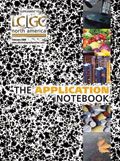US EPA Method 8260 Performance Evaluation with the Stratum PTC and SOLATek 72 Multi-Matrix Autosampler
The Application Notebook
EPA Method 8260 is used to determine volatile organic compounds (VOC's) in a variety of matrices including ground and surface waters. This method is commonly used in environmental laboratories where gas chromatography (GC), mass spectrometry (MS) and purge and trap (P&T) technology are used for the analysis and subsequent detection of VOC's.
EPA Method 8260 is used to determine volatile organic compounds (VOC's) in a variety of matrices including ground and surface waters. This method is commonly used in environmental laboratories where gas chromatography (GC), mass spectrometry (MS) and purge and trap (P&T) technology are used for the analysis and subsequent detection of VOC's.
Aqueous and soil sample analysis study was performed and linear calibration was demonstrated for 95 target analytes over the range of 0.5–200 ppb common P&T conditions. The Stratum PTC provides excellent water management and chromatographic results by incorporating a newly introduced and proprietary #9 analytical trap. Instrument conditions used for this analysis are suitable for Method 8260 in both soil and aqueous matrices.
Water vapor interference is a common problem in purge and trap analysis. When purging aqueous samples, water vapor is transferred with the analytes of interest onto the adsorbent trap and subsequently into onto the gas chromatograph (GC). In GC–MS this water vapor can cause inconsistent vacuum pressures and reduced ionization resulting in loss in stability of response over time. Traditionally, water vapor interference has been controlled by utilizing hydrophobic adsorbents in the analytical trap and passing an inert, moisture free gas through the adsorbents prior to desorption and onto the gas chromatograph. Depending on the detector and parameters this "dry purge" may not be completely effective in eliminating the interference. The Stratum PTC provides a revolutionary new way to remove water vapor after the concentration step in purge and trap analysis.
A high-flow dry purge is made possible with a programmable Mass Flow Controller that is built into the purge and trap device instrument allowing different flows for each mode. A new and novel configuration to the dry purge trap combined with a more efficient trap heater has dramatically improved the removal of water vapor. The dry purge trap is now configured into a "U"-shaped condensate trap. This combined with a redesign of the cooling fans and trap housing allows for a stable temperature of 20° C heating to the programmed bake temperature.

Figure 1: Total ion chromatogram of a 25 ppb.
Experimental-Instrument Conditions
An Agilent 6890/5973 GCMS, Stratum PTC and SOLATek 72 were used for this analysis. Data was obtained through the use of a 20 m X 0.18 mm X 1.0 µm RTX-VMS fused silica capillary column (Restek Corporation). A temperature profile from 35-210°C was utilized. The MS scanned in the full scan mode from 35-350 m/z at 5.27 scan/s.
Calibration
Calibration standards were prepared over the range of 0.5–200 μg/mL. Internal Standards were added using the Internal Standards Addition Module of the SOLATek 72 to hold at a constant concentration of 25 ppb. Sample volume was a 5 mL aliquot using the instrument conditions mentioned previously.
All analytes and their corresponding calibration data were evaluated using both the %RSD of the relative response factor and by calibration curve linearity. For most compounds the %RSD was <15% over the entire 0.5–200 ppb calibration range. For those target compounds with %RSD >15%, linear regression was employed with acceptance at 0.995 or greater, indicating linear response for all target analytes. This data met Method 8260 performance criteria.
Method Detection Limit (MDL) Determination
Analysis was performed to statistically determine the MDL's according to the procedure in Method 8260. Seven aliquots of a 1.0 ppb standard (waters) and 2.0 ppb (soils) were analyzed. The detection limit results for most of the compounds were 0.5 μg/L or less.
Carryover Evaluation
Evaluation for carryover of target analytes in subsequent blanks following a 200 ppb (water) and 400 ppb (soil) calibration standard. The Stratum PTC and SOLATek 72 performed remarkably well indicating <0.4% carryover in the first blank for all 95-target analytes evaluated.
Conclusion
The need for water removal from P&T analysis has been present since the introduction of P&T technology. The Stratum PTC is equipped with an innovative U-shaped condensate trap. The unique geometry of the trap aids in the removal of water that is typical in P&T analysis. The condensate trap offers improved water management and therefore a great replacement to early generation concentrators. Previous problems associated with carryover in P&T analysis have been addressed by reducing the sample pathway and a more uniform heating design.

Teledyne Tekmar
4736 Socialville Foster Road, Mason, OH 45040
tel. (800)874-2004, (513)229-7000, fax (513)229-7050
Website: www.teledynetekmar.com


.png&w=3840&q=75)

.png&w=3840&q=75)



.png&w=3840&q=75)



.png&w=3840&q=75)















